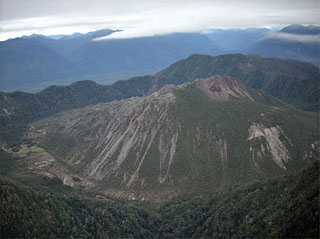Report on Chaiten (Chile) — 7 May-13 May 2008
Smithsonian Institution / US Geological Survey
Weekly Volcanic Activity Report, 7 May-13 May 2008
Managing Editor: Sally Sennert.
Please cite this report as:
Global Volcanism Program, 2008. Report on Chaiten (Chile) (Sennert, S, ed.). Weekly Volcanic Activity Report, 7 May-13 May 2008. Smithsonian Institution and US Geological Survey.
Chaiten
Chile
42.8349°S, 72.6514°W; summit elev. 1122 m
All times are local (unless otherwise noted)
Based on observations of satellite imagery, SIGMET reports, and pilot reports, the Buenos Aires VAAC reported that during 7-13 May ash plumes from Chaitén were continuously present and during 7-9 May rose to altitudes of 6.1-10.1 km (20,000-33,000 ft) a.s.l. The plumes drifted E and NE.
SERNAGEOMIN reported that on 7 May, seismicity from Chaitén increased and a large explosion was registered. On 8 May small pyroclastic flows traveled E and contacted the Rayas River, possibly causing steam plumes. During a break in the cloud cover, the ash-and-gas plume, present since 2 May, was seen rising to an altitude of 15.1 km (50,000 ft) a.s.l. and drifting NE. The W side of the plume was darker and denser. ONEMI (Oficina Nacional de Emergencia - Ministerio del Interior) reported ashfall in multiple areas on 7, 8, and 10 May.
On 12 May, the plume rose to an altitude of 8 km (26,200 ft) a.s.l. During an overflight conducted by SERNAGEOMIN, four more plumes of a similar altitude were generated by explosions and drifted NE. Several hectares of burned vegetation, likely from pyroclastic flows or lateral explosions, were noted on the N flank of the dome. Small pyroclastic flows may also have been responsible for completely burned forest to areas in the NE, and on the W and NW dome flanks. A lahar caused the banks of the Chaitén River to overflow about 200 m on each side, damaging about 40 houses and numerous cars that were partially or fully submerged. During an overflight on 13 May, evidence of pyroclastic flows on the N flank was observed. An ash-and-gas plume emitted from the lava dome drifted NE. The Alert Level remained at Red.
Geological Summary. Chaitén is a small caldera (~3 km in diameter) located 10 km NE of the town of Chaitén on the Gulf of Corcovado. Multiple explosive eruptions throughout the Holocene have been identified. A rhyolitic obsidian lava dome occupies much of the caldera floor. Obsidian cobbles from this dome found in the Blanco River are the source of artifacts from archaeological sites along the Pacific coast as far as 400 km from the volcano to the N and S. The caldera is breached on the SW side by a river that drains to the bay of Chaitén. The first recorded eruption, beginning in 2008, produced major rhyolitic explosive activity and building a new dome and tephra cone on the older rhyolite dome.
Sources: Servicio Nacional de Geología y Minería (SERNAGEOMIN), Buenos Aires Volcanic Ash Advisory Center (VAAC), Oficina Nacional de Emergencia-Ministerio del Interior (ONEMI)

